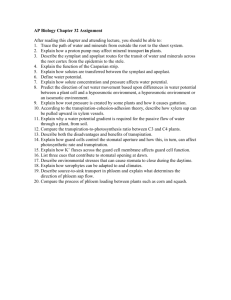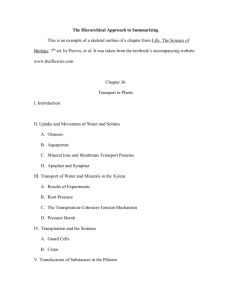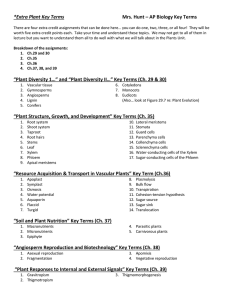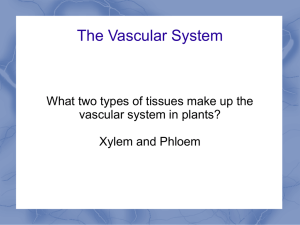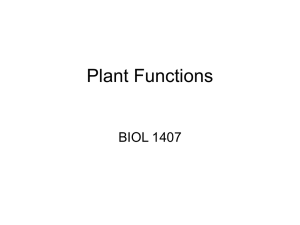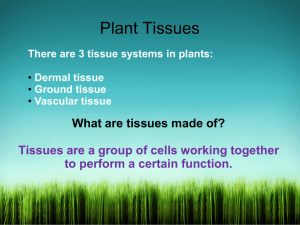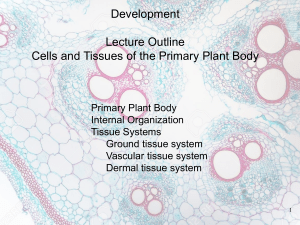Plant Tissue - Solon City Schools
advertisement
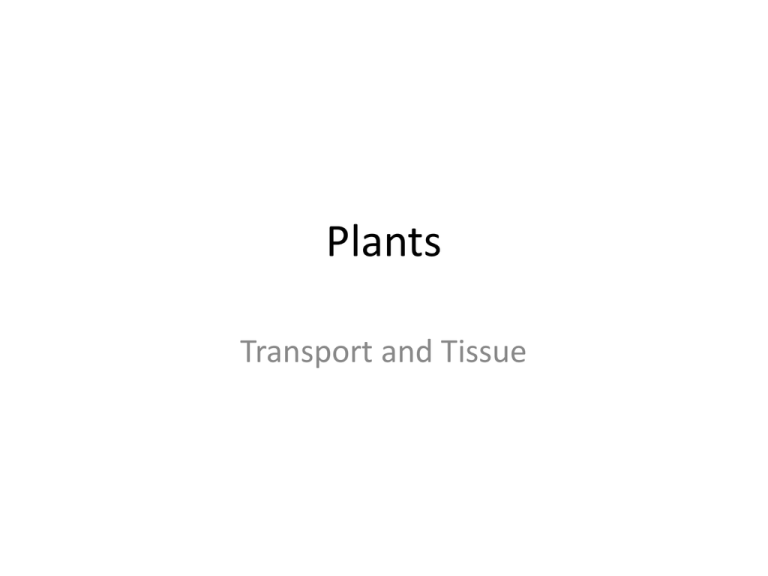
Plants Transport and Tissue Transport in plants • H2O & minerals – transport in xylem – transpiration • Sugars – transport in phloem – bulk flow • Gas exchange – photosynthesis • CO2 in; O2 out • stomates – respiration • O2 in; CO2 out • roots exchange gases within air spaces in soil Why does over-watering kill a plant? 2005-2006 Transport in plants • Physical forces drive transport at different scales – cellular • from environment into plant cells • transport of H2O & solutes into root hairs – short-distance transport • from cell to cell • loading of sugar from photosynthetic leaves into phloem sieve tubes – long-distance transport • transport in xylem & phloem throughout whole plant 2005-2006 Cellular transport • Active transport – solutes are moved into plant cells via active transport – central role of proton pumps • chemiosmosis proton pumps 2005-2006 Short distance (cell-to-cell) transport • Compartmentalized plant cells – cell wall – cell membrane • cytosol – vacuole • Movement from cell to cell – move through cytosol • plasmodesmata junctions connect cytosol of neighboring cells • symplast – move through cell wall apoplast • continuum of cell wall connecting cell to cell • apoplast symplast 2005-2006 Routes from cell to cell • Moving water & solutes between cells – transmembrane route • repeated crossing of plasma membranes • slowest route but offers more control – symplast route • move from cell to cell within cytosol – apoplast route • move through connected cell wall without crossing cell membrane • fastest route but never enter cell 2005-2006 Long distance transport • Bulk flow – movement of fluid driven by pressure • flow in xylem tracheids & vessels – negative pressure – transpiration creates negative pressure pulling xylem sap upwards from roots • flow in phloem sieve tubes – positive pressure – loading of sugar from photosynthetic leaf cells generates high positive pressure pushing phloem sap through tube 2005-2006 Movement of water in plants cells are flaccid plant is wilting • Water relations in plant cells is based on water potential – osmosis through aquaporins • transport proteins – water flows from high potential to low potential cells are turgid 2005-2006 Water & mineral uptake by roots • Mineral uptake by root hairs – dilute solution in soil – active transport pumps • this concentrates solutes (~100x) in root cells • Water uptake by root hairs – flow from high H2O potential to low H2O potential – creates root pressure 2005-2006 Controlling the route of water in root • Endodermis – cell layer surrounding vascular cylinder of root – lined with impervious Casparian strip – forces fluid through selective cell membrane & into symplast • filtered & forced into xylem vessels 2005-2006 Plant TISSUES • Dermal – epidermis (“skin” of plant) – single layer of tightly packed cells that covers & protects plant • Ground – bulk of plant tissue – photosynthetic mesophyll, storage • Vascular – transport system in shoots & roots – xylem & phloem Plant CELL types in plant tissues • Parenchyma – “typical” plant cells = least specialized – photosynthetic cells, storage cells – tissue of leaves, stem, fruit, storage roots • Collenchyma – unevenly thickened primary walls – support • Sclerenchyma – – – – very thick, “woody” secondary walls support rigid cells that can’t elongate dead at functional maturity Parenchyma Parenchyma cells are unspecialized, thin, flexible & carry out many metabolic functions all other cell types in plants develop from parenchyma Collenchyma Collenchyma cells have thicker primary walls & provide support help support without restraining growth remain alive in maturity the strings in celery stalks are collenchyma Sclerenchyma • Thick, rigid cell wall – lignin (wood) – cannot elongate – mostly dead at maturity • Cells for support – xylem vessels – xylem tracheids – fibers • rope fibers – sclereids • nutshells • seed coats • grittiness in pears vessel elements Xylem vessel element Vascular tissue move water & minerals up from roots dead cells at functional maturity only cell walls remain need empty pipes to efficiently move H2O transpirational pull dead cells Aaaah… Structure–Function again! tracheids Phloem: food-conducting cells carry sugars & nutrients throughout plant sieve tube companion cell sieve plate plasmodesmata living cells Phloem • Living cells at functional maturity – cell membrane, cytoplasm • control of diffusion – lose their nucleus, ribosomes & vacuole • more room for specialized transport of liquid food (sucrose) • Cells – sieve tubes • sieve plates — end walls — have pores to facilitate flow of fluid between cells – companion cells • nucleated cells connected to the sieve-tube • help sieve tubes
